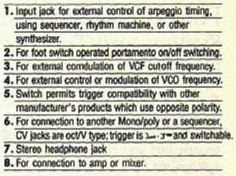image courtesy of the archives at Hyperreal
"4VCO Lead synth with mono- and polyphonic modes, arpeggiator, presettable sync and cross-mod effects and chord memory. Designed for stunning lead synthesizer sounds as well as polyphonic playing. The Korg Mono/Poly offers: three different keyboard assign modes: Unison, for the fattest 4-VCO lead sounds; Poly, for 4-note polyphonic capabilities; and Unison/Share which automatically switches between Unison and Poly modes; versatile Hold and Chord Memory functions, a full featured arpeggiator with three different patterns, three octave extensions and a unique "Latch" mode which automatically memorizes and sequences chords played. Each VCO features independent octave, waveform and level controls. The newly-developed 24dB/oct VCF offers continuously variable keyboard tracking (0-150%) and forward/reverse enveloping. Two separate Modulation Generators [LFO's] allow the user to set up two modulations at once. And the Effects section features "One-Touch" presettable Sync and Cross-Mod effects, along with Polyphonic Portamento." ----[from a Korg Mono/Poly brochure courtesy of the archives at Hyperreal]
The Mono/Poly is a 4-VCO monophonic synth with simple polyphony and a 3-1/2 octave, 44-note (F-C) keyboard which uses microprocessor-controlled scanning to achieve polyphony. Four-note polyphony is possible, however all voices use the same envelopes, VCA and VCF, thus not making it a true polyphonic synth. Unfortunately the Mono/Poly came out at the time when true polyphonic synths were the "next big thing" and it didn't sell as well as the Polysix, Korg's entry into the hot polyphonic market.
All VCO's have knobs for tuning, waveform, octave (16', 8', 4', 2'), and volume/level. VCO1's tune control doubles as an overall tune for all of the oscillators, so that you can set VC02, VCO3, and VCO4 to separate intervals and still control overall tuning. Available waveforms are triangle, sawtooth and pulse width with pulse width modulation. However, there is only a single set of controls for overall pulse width modulation affecting all oscillators' pulse width modulation equally. Along with a single knob setting pulse width, there is a knob for modulation sensitivity and a switch for source (VCF EG, MG1 and MG2). There is a single knob for portamento amount. Another knob controls the level of the white-noise. A Detune knob tunes VCO4 +/- 35 cents from VCO2.
The VCF is a resonant low-pass 24dB/octave filter with knobs for cutoff frequency, resonance, keyboard tracking (which, incidentally, doesn't work with CV control), and envelope modulation (variable between negative, to none, to positive). There are two ADSR envelope generators, one for the VCF and one for the VCA. The VCA envelope generator is switchable between single and multiple triggering.
There are two LFOs, called MG's (modulation generators). MG1 is linked to the mod wheel and has controls for rate (0.1Hz to 30Hz), and waveform (triangle, sawtooth, ramp, and square). MG2 (triangle wave only) is linked to the arpeggiator and only has a knob for rate, which has a very wide range (0.1Hz to 30Hz). There are controls for overall portamento and detune, and a switch for transposition (an octave up or down). The arpeggiator is much like the Polysix. It has a switchable range of 1 octave, 2 octaves, and full. It can be set in up, down or up/down modes and it is latchable. Hold and chord memory also function similar to the Polysix. A very useful function is the Unison/Share mode. When in this mode, The Mono/Poly forces all oscillators to play no matter how many notes are held down. This produces a 4-VCO monophonic sound.
Probably the most interesting and useful features are found in the Mono/Poly's "Effect" section. In this section oscillator sync (called "Syncro") and cross-modulation (Called "X-Modulation") is available. There are knobs for both X-Modulation sensitivity and Synchro sensitivity. Both sync and cross-modulation have two modes: "Single" and "Double". In "Single" mode, Syncro uses VCO1 as the master, syncing the other VCOs to it and X-Modulation similarly uses VCO1 as a master, modulating other VCOs by it. In Double mode, VCO1 and VCO2 are masters, syncing VCO3 to VCO1 and VCO4 to VCO2 and similarly modulating VCO3 by VCO1 and VCO4 by VCO2. The nice thing about the Mono/Poly is that both sync and cross-modulation can happen at the same time. There is a single button turning on the "Effects" section and a switch choosing between Synchro, Cross-Modulation or both. Another switch chooses an additional VCO modulation source (VCF EG or MG1) with a knob adjusting modulation amount.
To the left of the keyboard are two controller wheels. The first, a non-spring-loaded, center-normal pitch-bend wheel has a sensitivity knob and a switch choosing between VCO/Slave VCO, overall pitch, and the VCF. The second, a traditional mod wheel controlling MG1 (LFO1), has a sensitivity knob and a switch choosing between the same modulation destinations: VCO/Slave VCO, overall pitch, and the VCF.

 On the back there is a headphone jack, an output jack with a level selector (Off, Low, High), an Arpeggiator trigger input with a polarity switch, a portamento switch input, as well as inputs for VCO and VCF modulation. There are also CV/gate inputs and outputs (unfortunately mono only). However, Korg finaly used 1 Volt/octave (as opposed to Korg's hitherto standard 1 Hz/octave). The gate input is also very useful in that it is switchable between +15 and s-trig modes. Unfortunately, there is no audio input.
On the back there is a headphone jack, an output jack with a level selector (Off, Low, High), an Arpeggiator trigger input with a polarity switch, a portamento switch input, as well as inputs for VCO and VCF modulation. There are also CV/gate inputs and outputs (unfortunately mono only). However, Korg finaly used 1 Volt/octave (as opposed to Korg's hitherto standard 1 Hz/octave). The gate input is also very useful in that it is switchable between +15 and s-trig modes. Unfortunately, there is no audio input.
The Mono/Poly weighs approximately 12kg and it's dimensions are 744mm(width) X 450mm(depth) X 144mm(height) and it has wooden end panels.

